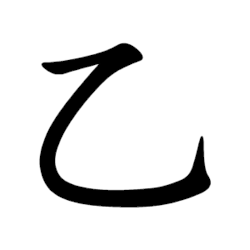Radical 5
| 乙 | ||
|---|---|---|
| ||
| 乙 (U+4E59) "second, fishing hook" | ||
| Pronunciations | ||
| Pinyin: | yǐ | |
| Bopomofo: | 一ˇ | |
| Gwoyeu Romatzyh: | yii | |
| Wade–Giles: | i3 | |
| Cantonese Yale: | yut | |
| Jyutping: | jyut3 | |
| Pe̍h-ōe-jī: | it | |
| Japanese Kana: | オツ otsu (on'yomi) きのと kinoto /おと oto (kun'yomi) | |
| Sino-Korean: | 을 eul | |
| Hán-Việt: | ất | |
| Names | ||
| Japanese name(s): | 乙 otsu 乙繞/おつにょう otsunyoū 釣り針/つりばり tsuribari (fishing hook) | |
| Hangul: | 새 sae | |
| Stroke order animation | ||
 | ||
Radical 5 or radical second (乙部), meaning "second", is one of 6 of the 214 Kangxi radicals that are composed of only one stroke. However, this radical is mainly used to categorize miscellaneous characters otherwise not belonging to any radical, mainly featuring a hook or fold, and 乙 is the character with the fewest strokes.
In the ancient Chinese cyclic character numeral system, 乙 represents the second Celestial stem (天干 tiāngān).
In the Kangxi Dictionary, there are 42 characters (out of 49,030) to be found under this radical.
In mainland China, 乙 along with other 14 associated indexing components, including 乚, etc., are affiliated to a new radical 乛 (乛部), which is the 5th principal indexing component in the Table of Indexing Chinese Character Components predominantly adopted by Simplified Chinese dictionaries.[1] Usually, only several out of the 15 variant components are listed under radical 乛 in dictionary indexes.
Evolution
-
 Oracle bone script character
Oracle bone script character -
 Bronze script character
Bronze script character -
 Large seal script character
Large seal script character -
 Small seal script character
Small seal script character
Derived characters
| Strokes | Characters |
|---|---|
| +0 | 乙 乚 乛Component only |
| +1 | 乜 九 |
| +2 | 乞 也 习SC (=習 -> 羽) |
| +3 | 乢 乣 乤KO 乥KO |
| +4 | 乧KO |
| +5 | 乨 乩 乪 乫KO 乬KO 乭KO 乮KO 乯KO |
| +6 | 乱 (SC/JP, =亂) 乲KO |
| +7 | 乳 乴KO 乵KO 乶KO 乷KO 乸 |
| +8 | 乹 乺KO 乻KO 乼KO 乽KO |
| +10 | 乾 乿 亀JP (=龜 -> 龜) |
| +11 | 亁 (=乾) |
| +12 | 亂 亃 亄 |
In the Unihan Database, 亀 (Japanese simplified form of 龜) falls under Radical 5 + 10 strokes, while other variants of 龜 (including Simplified Chinese 龟) fall under Radical 213 (龜 "turtle"), causing an inconsistency. However, in most Japanese dictionaries, 亀 is treated as a variant of Radical 213 (龜) and indexed Radical 213 + 0 strokes.
Sinogram
As an independent character it is a Jōyō kanji, or a kanji used in writing the Japanese language. It is a secondary school kanji.[2] It is also used in the Chinese language.
It means "secondary" and is mainly used in compounds.
See also
References
- ^ GF 0011–2009 汉字部首表 (The Table of Indexing Chinese Character Component [sic])
- ^ "KANJI-Link". www.kanji-link.com. Retrieved 2023-06-02.
Further reading
- Fazzioli, Edoardo (1987). Chinese calligraphy : from pictograph to ideogram : the history of 214 essential Chinese/Japanese characters. calligraphy by Rebecca Hon Ko. New York: Abbeville Press. ISBN 0-89659-774-1.
- Leyi, Li (1993). Tracing the Roots of Chinese Characters: 500 Cases. Beijing. ISBN 978-7-5619-0204-2.
{{cite book}}: CS1 maint: location missing publisher (link)